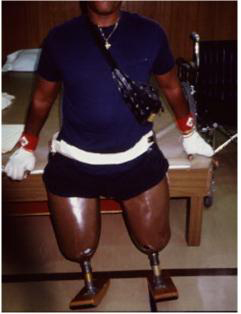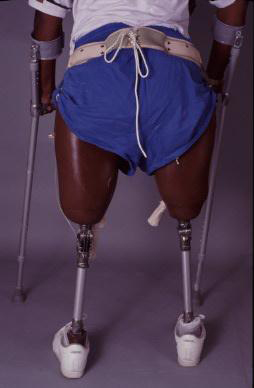|
The Use of Stubbies for Bilateral Above Knee Amputees
Bilateral above knee amputees are faced with a unique challenge in that they must overcome the loss of both knees and both feet. This poses a significant obstacle in balance and energy expenditure.
A typical above knee prosthetic limb usually incorporates three elements:
A prosthetic socket, a prosthetic knee and a prosthetic foot

New bilateral above knee amputees often begin prosthetic rehabilitation with a more unconventional approach. A stubby is an above knee prosthetic leg that does not include a knee joint. The benefits of not including a knee joint for a new bilateral above knee amputation would be:
The overall height of the prostheses would be shorter. The further a person is from the ground, the harder that person could fall. Shorter prostheses reduce the amputee’s over height and could reduce impact in a tumble.
The prosthetic user can master one prosthetic joint at a time: initially the ankle/foot, with the subsequent addition of the prosthetic knee unit.
This allows the user to focus on building upper body strength, which is crucial for bilateral above knee amputees.
This stage in rehabilitation is often used to determine if the bilateral above knee amputee is a prosthetic candidate.
This design requires less energy expenditure.
Stubbies, sometimes referred to as foreshortened prostheses, can include a variety of foot designs, ranging from standard prosthetic ankle/feet to rocker bottom platforms. If standard prosthetic feet are to be utilized, they are often set in a backwards position, with the heels facing the front. This is to help prevent the amputee from falling backwards. Rocker bottoms, although not realistic, offer greater anterior and posterior horizontal support equally. This increased ground level support provides an increased level of stability for the user.
Stubbies are often considered a transition into conventional above knee prosthetics, but many users prefer to stick with this design exclusively. For those eventually adding prosthetic knee units to the prostheses, additional gait training and therapy is highly indicated. The addition of prosthetic knees will add an increase the level of instability and vertical height.
The use of standard bilateral above knee prosthetic designs, with knee units, is considered a great challenge for the user. It should be noted that many bilateral above knee amputees have been able to master these prostheses with great skill, even achieving professional athletic status. Commonly, users who transition from stubbies to conventional above knee prostheses will use other assistive devices, such as crutches, for increased stability. It is recommended that any bilateral above knee prosthetic user have access to additional assistive devices, such as a wheelchair, a walker, and/or crutches.
These additional assistive devices could be utilized daily, or on an as-needed basis. Bilateral above knee amputees with severe cardiac issues may not be considered candidates for conventional bilateral above knee prosthesis, due to the energy expenditure required.

Successful bilateral above knee prosthetic rehabilitation requires an extremely cohesive rehabilitation team. Communication between the prosthetist, therapist and physician is vital to ensure that all rehabilitation goals are being met and that the amputee is able to meet his or her functional potential.
|